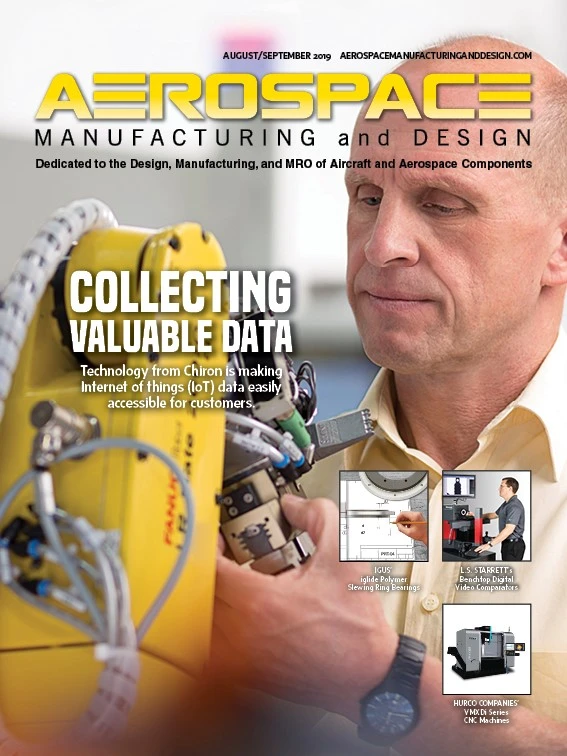
Critical aerospace engine turbine fan blades and high-bypass turbines produce much of the forward thrust. In the past, precision-forged blades needed only light finishing to achieve tolerances. Growing requirements for fuel efficiency now demand tighter tolerances, and many manufacturers have responded by machining oversize forgings to final net shape.
Typically machined from titanium alloys, newer blade materials include aluminum and carbon-fiber composites. Carbon-fiber blades attach titanium leading edges to the relatively brittle composite material – a design element minimizing damage if an engine ingests foreign objects. Titanium aluminide used in blades in the low-pressure sections of some new engines is very brittle but provides high heat resistance.
Futuristic materials and the complex shapes required to securely unite them into a single turbine blade need equally futuristic machining processes – particularly when it comes to machine movement. Changing direction quickly is important in machining as it is in auto racing. On a straight track, acceleration and deceleration are relatively simple, but when the track turns, the car must decelerate to negotiate the corner and accelerate back to top speed again. The winning car will decelerate into the curve, track the turn accurately, and accelerate back out more quickly than competitors.
When machining the edges of a turbine blade, 5-axis movement is much more demanding than driving on a race circuit, but the principles are the same. Machines must move tools around the blade edges at speeds that can produce as much as 1g of acceleration and deceleration force to maximize productivity. To meet the standards of aerospace manufacturers, the machine must also produce a high-quality, finished blade that requires minimal polishing and less bench work than a blade processed on a general-application machine.
“Changing direction quickly is important in machining as it is in auto racing.”
High g resistance
GF Machining Solutions’ Liechti Turbomill 1400 g airfoil machining platform meets these challenges. An advanced turbine blade mill designed for fast, cost-efficient production of medium-to-large blades for jet engines and power generation, the Liechti Turbomill 1400 g clamps a blade at each end and spins it between centers while a milling tool moves around the blade. That motion creates complex airfoil contours, allowing the machine to perform heavy-duty roughing and dynamic finishing for the airfoil, root form, and shroud.
The mill rapidly creates complex profiles on the leading and trailing edges of the blades that control airflow into the engine while maintaining the tight tolerances that maximize fuel efficiency. Some machine tools can start and stop simple straight-line machine movements at 2g. The 1400 g performs accurate three-dimensional machining at 1g.
Acceleration and deceleration at 1g generate significant force – strong enough to topple the machine over if it is not securely anchored to the shop floor. The Liechti Turbomill 1400 g uses its large size, weight, and rigidity to resist these forces. Machine ways are engineered with the strength to handle extreme momentum and inertia. The X-axis moves via linear drive, the Y- and Z-axis on ballscrews, and direct-drive motors power the rotary B- and A-axis, which is key to moving tools quickly around a blade’s leading and trailing edges.
The Liechti Turbomill 1400 g specializes in high-volume turbine blade production at original equipment manufacturers (OEMs) or large Tier 1 suppliers that require maximum throughput of similar part families, machining blades up to 2x faster than general-purpose machines.
Global competition and increasingly strict product quality, performance, and manufacturing efficiency requirements have heavily influenced the design and production of turbine engines, forcing OEMs to meet customer requirements while manufacturing blades quickly and economically.
GF Machining Solutions is using a Liechti Turbomill 1400 g at its Aerospace Center of Competence (CoC) in Huntersville, North Carolina, where the company develops turn-key processes, conducts prototype machining, and provides CAM and programming training. There is also a secure area for military ITAR development.

Explore the August September 2019 Issue
Check out more from this issue and find your next story to read.
Latest from Aerospace Manufacturing and Design
- America Makes announces QTIME project call
- Innovation meets precision for 40% faster machining
- Upcoming webinar: Pro tips from a supply chain strategist
- Heart Aerospace relocates to Los Angeles
- Fixtureworks introduces Stablelock Clamps
- Piasecki acquires Kaman's KARGO UAV program
- PI Americas’ long-travel XY piezo nanopositioners-scanners
- AAMI project call submission deadline extended to May 12








